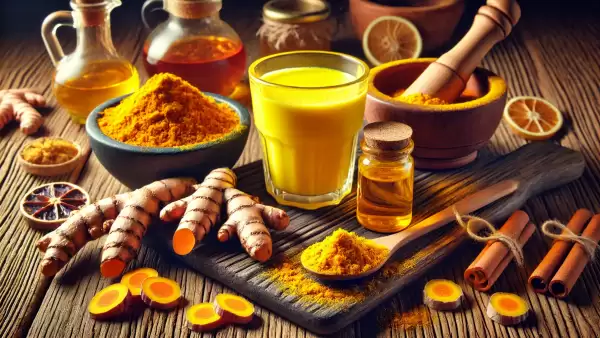Turmeric
Turmeric (Curcuma) - The gold dust of health and gastronomy ✨

Turmeric is used successfully in gastronomy and it is well known for its medicinal properties against high cholesterol, osteoarthritis or cancer, among many other deseases.
Turmeric, also known as turmeric or Indian saffron, is one of the most appreciated herbs, due to its gastronomic versatility, but also for its medicinal healing properties.
What is turmeric? 🧐
A plant from southwest India that belongs to the same family as ginger (zingiberaceae), turmeric began to be used around 4,000 years ago. In Sanskrit, the word kunkuma was used specifically for turmeric, hence the name turmeric, turmeric is also known as turmeric.
How is turmeric powder made? 🌾
By shaving and drying its stem, which grows underground and horizontally, a yellow powder containing between 2 and 5% curcumin, a compound that is attributed with health benefits, is obtained.
❗ Caution. However, turmeric powder should not be confused with curry, which is a mixture of several spices, including turmeric, paprika, coriander, ginger, ginger, cumin.
Turmeric, the gold dust of gastronomy
The culinary use of turmeric is more deeply rooted in Asia, and thanks to its sweet, spicy and slightly bitter-sweet flavor, turmeric has become known worldwide.
Today, turmeric is one of the most popular spices among chefs who use it as a wonder ingredient in their dishes. In color, in aroma, in flavor, turmeric stands out for its magical properties.
What do we use turmeric for?
We can use turmeric as:
- Seasoning: to season rice, meat, fish, salads, etc.
- food coloring: to color cheeses, sauces, dairy products, juices, etc.
Nutritional information per 100 grams
- 🔥Calories: 354 cal.
- 💪Protein: 7.80 g
- 🍞Fluids (carbohydrates): 64.90 g
- 🥑 Lipids (fats): 9.90 g
Turmeric contains fiber, protein, niacin, vitamins C, E and K, sodium, potassium, calcium, copper, iron, magnesium, zinc, etc. However, as the amount consumed in preparations is small, its nutritional value is also low.
Its proportion can be increased if consumed as a nutritional supplement, but only on the advice of a specialist doctor.
❗ Note: The quantities consumed daily are small, so the nutritional intake is low, but the therapeutic effects are remarkable!
Health benefits of turmeric
Due to its anti-inflammatory and antioxidant properties, turmeric is successfully used for:
- ✅ Detoxifying the body
- ✅Fighting flu and colds 🤧
- ✅Skin conditions: acne, eczema, psoriasis, healing cuts, wounds and injuries.
- ✅Allergy relief
- ✅ Asthma relief
- ✅ Treatments for gastric ulcers
- ✅ Treatments for irritable colon
- ✅Glycemia regulation in diabetes (reducing blood sugar levels)
- ✅Cholesterol reduction
- ✅ Relieving arthritis and osteoarthritis )osteoarthritis of the hand, hip or knee)
- ✅Support therapy in ulcerative colitis
- ✅ Arthritis, rheumatoid arthritis, psoriatic arthritis, knee arthritis
- ✅Possible anticarcinogenic effects (studies ongoing)
How to take turmeric correctly?🥄
Consuming turmeric as a nutritional supplement is considered safe when taken orally or topically, and the amount differs depending on the condition we are dealing with, so it is recommended to take it only on the recommendation of your specialist.
Turmeric can be consumed in several ways:
- Powdered in food - Added to soups, rice, smoothies.
- Turmeric tea - Boil a teaspoon of powder in water and add honey 🍯.
- Golden milk - Turmeric + vegetable milk + honey + cinnamon.
- Turmeric paste - For application on the skin for eczema.
- Supplements - Capsules with curcumin extract (only on doctor's recommendation!).
Natural remedies with turmeric 🌱
1️⃣Remediu for immunity:
🥣Golden Milk
Ingredients:
- 1 cup almond/coconut milk 🥥
- 1 tsp turmeric
- ½ teaspoon cinnamon
- 1 tbsp honey 🍯
Preparation: Heat the milk and mix all the ingredients together. Consume in the evening for relaxation and a strong immune system.
2️⃣Remediu for joint pain:
🥣An anti-inflammatory paste
Ingredients:
- 2 tablespoons turmeric powder
- 1 tablespoon coconut oil 🥥
- 1 teaspoon black pepper (improves curcumin absorption!)
How to use: Apply topically to painful areas for 20 minutes, then rinse.
3️⃣Remediu for digestion:
🥣Turmeric and ginger tea
Ingredients:
- 1 teaspoon turmeric
- 1 teaspoon grated ginger
- 250 ml hot water
- 1 teaspoon honey 🍯
Preparation: steep for 10 minutes, then strain and drink after meals.
Side effects
When not used properly and in the right amount, turmeric can have side effects, including:
- nausea
- diarrhea
- stomach upset
- increased menstrual flow
- bleeding
- hypotension (low blood pressure)
Contraindications
Turmeric is not recommended for pregnant or breastfeeding women, as its consumption may endanger pregnancy and the health of mothers.
Used correctly and in the right quantity, turmeric works wonders
As we have seen, turmeric powder fully deserves its name as a magic powder, but it should only be used in small quantities to prepare delicious dishes and only on the advice of a specialist doctor for therapeutic purposes.
So let's use it properly and enjoy its incredible gastronomic and health properties.
✨ Conclusion
Turmeric is a true superfood, but it must be consumed correctly to maximize its benefits. Used in recipes or as a herbal remedy, it can bring you multiple health benefits! 💛
Did you know...? 🤓
- 🏆 Turmeric is considered "Indian Gold" because of its benefits.
- 🩸 Curcumin improves blood circulation and prevents blood clots.
- 🥄 Turmeric's absorption increases 20 times when combined with black pepper!
- 🏛️ It was used in Ayurvedic medicine over 4,000 years ago.
- 🧴 It is used in cosmetics for its anti-aging effect.
- 🏺 In the past, it was used as a natural fabric dye.
- 💊 Helps reduce oxidative stress and improve brain function.
- 🏋️♂️ Helps muscle recovery after strenuous exercise.
- 🔬 Studies suggest it may have beneficial effects on depression.
- 🏠 It's a natural insect repellent!
Comments